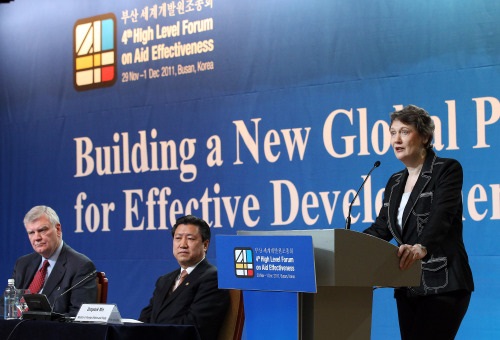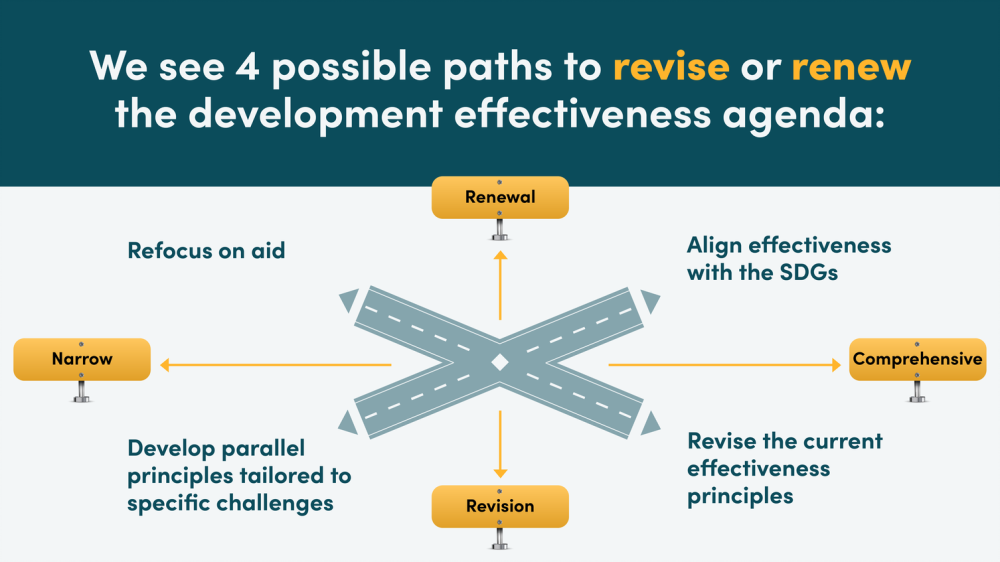Recommended
In December 2022, the international development community gathered in Geneva (and online) for the third High-Level Meeting (HLM) of the Global Partnership for Effective Development Cooperation (GPEDC). In recent years, declining political interest and stalled progress towards effectiveness targets have led some to argue that the agenda is at best “insufficient” for guiding best practice in a changing development landscape, and at worst, “dead”. The Summit presented an important opportunity for the GPEDC to not only reaffirm the importance of development effectiveness, at this critical juncture, but to provide a clear plan for reviving the agenda in the years ahead.
In this blog, we ask whether the Effectiveness Summit brought about the change needed to renew momentum for effective development cooperation. We assess the Summit’s outcome against four reform scenarios proposed in a recent CGD paper. Ultimately, we find that the direction of travel set at the Geneva Effectiveness Summit represents a largely “business as usual” approach, which may not be enough to revitalize this agenda and overcome the barriers to its implementation.
Revision versus renewal: the challenges facing effectiveness and options for reform
In a CGD survey of development officials published last year, we found that while the effectiveness principles were broadly seen as relevant and useful, a majority said that the agenda should change to overcome the technical, strategic and political challenges that were limiting its implementation. Based on the full range of responses, we identified four potential scenarios for reforming the effectiveness agenda, which are organized around two key trade-offs. The first trade-off concerns the ambitiousness of potential reform scenarios, ranging from a modest “revision” of the agenda to a broader and more ambitious “renewal”, aimed at reigniting political interest. The second trade-off concerns the coverage of the agenda in terms of the actors, modalities, and flows covered under each option, ranging from narrower to broader coverage (see Figure 1).
Figure 1: Framework of scenarios for the future of the effectiveness agenda
Within these dimensions, we developed four scenarios, each of which is necessarily imperfect due to the trade-offs involved. Scenario 1 proposes an ambitious re-think of the effectiveness agenda to align the principles with global—as well as local—action needed to address the UN’s Sustainable Development Goals (SDGs). Scenario 2 involves a modest revision of the current effectiveness framework to account for changes in the global development landscape; clarify the applicability of effectiveness principles to different contexts; and re-engage diverse development actors. Scenario 3 entails the creation of sub-principles alongside the current effectiveness agenda or clarifying the applicability of the current principles to different actors, flows, or contexts. Scenario 4 involves narrowing the development effectiveness agenda to refocus on the changing roles and purposes of Official Development Assistance (ODA) flows, on the understanding that ODA is a unique and limited resource that must be used effectively. While these scenarios are presented as individual options, in reality, each can be combined and used to different degrees.
The Geneva Summit outcome: which path was taken and how does it align with reform scenarios?
The GPEDC set the effectiveness agenda on a path to clarify the applicability of the principles through changes to the monitoring exercise, anchoring the effectiveness agenda at the country and local levels, and introducing “toolkits” and parallel principles for targeted actors and contexts. This focus on refining and clarifying the application of the effectiveness principles suggests the strongest alignment with Scenario 2, which involves a modest “revision” of the current agenda rather than a wide-scale “renewal” (Scenario 1). The focus on specialized principles and tools, meanwhile, aligns with Scenario 3.
The primary alignment with Scenario 2 is based on two key features of the Geneva Summit outcome. First, the Summit launched a substantive reform of the GPEDC monitoring exercise, covering both the indicators included in the framework, as well as the overarching monitoring process. Specifically, the new monitoring tool will include efforts to track the effectiveness of private sector engagement, monitor progress towards leaving no one behind, and a tailored approach for monitoring effectiveness in fragile and conflict-affected states, while the monitoring process will take place on a rolling basis on a four-year cycle. Second, the Summit launched a new “Delivery Model” aimed at increasing the relevance and highlighting the applicability of the effectiveness principles at the country level. In both cases, the reforms taken aimed to clarify the technical applicability of the effectiveness principles in specific contexts, and amount to a “revision” of the current framework rather than a substantive change in direction.
The Summit’s Outcome document also included elements of Scenario 3, which is centered around the creation of parallel principles tailored to specific challenges. In particular, the introduction of new Principles for Improving Development Impact in Small Island Developing States (SIDS) and the Kampala Principles Toolkit broadly match this scenario by providing additional advice and clarification to different groups of development actors on best practice for engaging in SIDS and how to engage in private sector partnership.
The paths not taken were Scenarios 1 and 4, both of which required a higher level of ambition and would involve more substantive change. While the outcome document—and corresponding GPEDC output—shows an attempt to re-frame the effectiveness agenda to address the SGDs, it falls short of the broad-scale reform proposed under Scenario 1, which demands a re-interpretation of the effectiveness principles to address complex cross-border challenges underlying the SDGs. The continued focus on a broad range of cooperation modalities also indicated no real alignment with Scenario 4, which proposes a re-focus on ODA.
What are the implications of this combined trajectory?
While the Geneva Summit made strides towards addressing some of the implementation challenges of the effectiveness agenda through changes aimed at clarifying the monitoring and application of the principles, which should—at the very least—contribute to deeper understanding of how the principles can be operationalized, it largely opted for scenarios that are unlikely to address strategic or political barriers to implementation. For instance, while the Summit Outcome’s narrative stressed the importance of effectiveness to achieve the SDGs, it fell short of articulating what it means for development actors to be effective in the context of global development challenges. The fundamental question of “what does it mean to be effective” in a development context defined by both global and local challenges, and where development resources are increasingly used to provide global public goods, is seemingly unaddressed. This is surprising given the importance of such challenges for achieving the SDGs, and in light of findings from our survey, which showed that while the effectiveness framework remains relevant, there is demand for change, including through the development of new or adapted principles to account for shifts in the global development landscape.
At the same time, there is a risk that this approach will do little to renew political interest in effectiveness, the decline of which has hindered the implementation of the principles. Our survey showed that political interest in effectiveness is critical to providing staff with the incentives, capabilities, and mandate to implement effectiveness commitments. At the same time, declining interest in the agenda begets more decline, where the perception of the agenda’s waning influence—particularly amongst providers beyond the OECD-DAC—reduces it further (i.e. a global agenda needs global engagement to meaningfully survive). While the GPEDC’s chosen trajectory was perhaps the most politically palatable option, it is unlikely this “revision” alone can meaningfully revive the political impetus for effectiveness needed to drive action, particularly in a development context where geostrategic pressures mean that the “what” of development often takes precedence over the “how” of effectiveness.
The GPEDC missed a chance for reform and needs a new direction to survive
Overall, the new revisions and changes launched at the 2022 Effectiveness Summit did little to clarify a direction for a reinvigorated effectiveness agenda suited to the challenges of the SDG era. This “more-of-the-same” trajectory is unlikely to deepen the chances of the agenda’s survival.
In the years ahead, the new GPEDC co-Chairs must make a concerted effort towards meaningful change in order to re-new engagement and re-assert the importance of effectiveness in the minds of policy-makers, with the ultimate aim of driving action and improving implementation. Without such change, it is difficult to see how the agenda can be put on a course where effectiveness is not only relevant in the changing landscape, but necessary for meeting the development challenges ahead.
The authors would like to thank Mikaela Gavas and Beata Cichocka for their helpful comments and suggestions.
Disclaimer
CGD blog posts reflect the views of the authors, drawing on prior research and experience in their areas of expertise. CGD is a nonpartisan, independent organization and does not take institutional positions.
Image credit for social media/web: Adobe Stock







